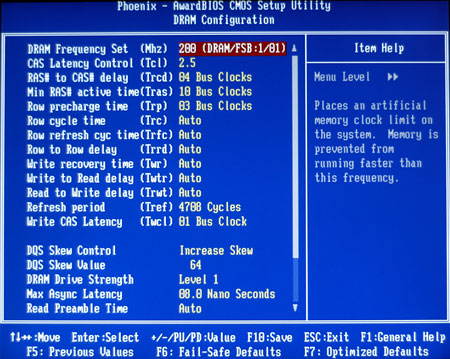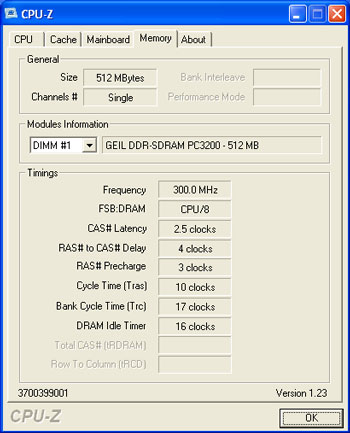DFI LANParty UT nF3-250Gb: Overclocker's Dream
by Wesley Fink on September 8, 2004 12:05 AM EST- Posted in
- Motherboards
FSB Overclocking: DFI LANParty UT nF3 250Gb
DFI has given users just about everything that they could ask for in the way of overclocking options. So, what can you do with all those wonderful options for overclocking? We have already seen great results from the MSI K8N Neo and other Socket 754 boards, so we hoped that we could do even more with the DFI LANParty UT. We weren't disappointed.| Front Side Bus Overclocking Testbed | |
| Default Voltage | |
| Processor: | Athlon 64 3200+ 2.0GHz |
| CPU Voltage: | 1.5V (default) |
| Cooling: | Thermaltake Silent Boost K8 Heatsink/Fan |
| Power Supply: | OCZ Power Stream 520W |
| Hard Drive: | Maxtor MaXLine III 250GB SATA (16MB Cache) |
| Memory: | OCZ PC3200 EL Platinum Rev. 2 or Geil PC3200 Ultra X |
| Maximum OC: (Standard Ratio) |
248x10 2470MHz (+24%) |
| Maximum FSB: (Lower Ratio) |
308 x 8 {1:1 Memory, 1 DIMM) 270 x 9 at (1:1 Memory, 2 DIMMs) |
This late 3200+ tops out around 245 to 246CPU setting at stock multiplier on the best overclocking boards. It reached 248 on the DFI nF3 250Gb at stock 10X ratio and stock voltage, which should be considered the limit of this CPU.
The performance at lower ratios, on the other hand, took our memory to performance levels never reached on any board - AMD or Intel. Both the Geil and OCZ memories are based on very recent Samsung TCCD memory chips, which performed well in our recent memory tests on an Intel test bed. They topped out at DDR557 to 561 on the Intel, so I was skeptical when DFI told me that TCCD memory could reach DDR600 on the nF3-250Gb. With a little tweaking, we were able to reach even further with this same memory, to DDR616 at 3-3-4-10 memory timings at 2.8V memory voltage.
It is significant that these record 1:1 overclocks were achieved with a SATA hard drive, since SATA drives are often an issue when overclocking Intel 775 boards. The SATA lock certainly appears to be working very well on this production DFI nVidia nF3 250Gb board.

DDR616 is the highest memory speed that we have ever reached on any board in our overclocking, with this memory or any other including DDR550. When you consider this is a 54% overclock of the memory's rated speed of DDR400, it puts into perspective the astounding performance of this memory on the DFI nF3 250Gb. To give you a better idea of what it took to reach DDR616, below is a BIOS shot of the memory timings to reach this milestone.

With a bit more tweaking, we managed to reach stable DDR600 performance with 2.5-3-4-10 memory timings with the OCZ and Geil at memory voltage of 2.8V. These are really aggressive timings for a memory running at DDR600.

We were able to achieve even faster 2.5-2-2-10 timings at DDR586 with OCZ3700EB, but it required the board limit of 3.1V to achieve stability at this speed. We have seen reports on the web of some achieving near DDR600 with OCZ3700EB on the beta DFI with 3.2V.
Please keep in mind that these incredible overclocks were achieved with 1 DIMM in this single channel board. We also tested 2 DIMMs of the same memory and found that we topped out at 270 CPU setting (DDR540) with the TCCD DIMMs. The "Auto" setting on Hyper Transport speed seemed to handle anything we threw at the DFI without complaint.
Front Side Bus Stress Test Results:
As part of our overclocking tests, a full range of stress tests and benchmarks were run to ensure that the DFI LANParty UT was stable at each overclocked FSB speed. This included Prime95 torture tests, and the addition of other tasks - data compression, various DX8 and DX9 games, and apps like Word and Excel - while Prime95 was running in the background. Finally, we ran our benchmark suite, which includes Veritest Winstone 2004 suite, Unreal Tournament 2003, SPECviewperf 7.1, and Aquamark 3. 248MHz was the highest overclock that we were able to achieve with the DFI while running these tests at default voltage - an outstanding performance with the Athlon 64.We were also able to complete stress testing at 300x8 with 2.5-3-4-10 memory timings. At that speed of 2.4Ghz at DDR600, we achieved the following results:
- Quake 3 - 474.0
- Return to Castle Wolfenstein-Enemy Territory-Radar - 104.3
- Sisoft Sandra 2004 - Standard Buffered - 4670/4673
- Sisoft Sandra 2004 - UnBuffered - 2583/2600










54 Comments
View All Comments
Bozo Galora - Wednesday, September 8, 2004 - link
#33 - yeah whats up with thatbest perf with one stick, but only 512
and BTW:ZZF had them $135, went out the door fast
ukDave - Wednesday, September 8, 2004 - link
Also, i've just been checking DFI's site and it says it only supports 512MB DIMMs, bit of a bummer cos i was thinking of getting a single 1GB stick, sux0r.ukDave - Wednesday, September 8, 2004 - link
Great article Wesley. Lucky for you guys in the states DFI's RMA process is actually good, here in Europe (UK) we have to deal with DFI NL (Netherlands), and they tbh are crap. So bad in-fact some retailers are debating whether to carry future boards from DFI. I certainly hope they do though, as this board sure looks like a belter, and it WILL be replacing my Asus K8V-SE Deluxe which has no PCI lock (although its still a great board).cnq - Wednesday, September 8, 2004 - link
For everyone looking for "754 overclocking for dummies" guide: it's already been written. Check outhttp://www.dugu9tweaks.net/guides/a64oc/index.html
8NP4iN - Wednesday, September 8, 2004 - link
/me wants oveclocking for dummies guide 2 :]sprockkets - Wednesday, September 8, 2004 - link
No UV reactive green like the other boards? :(JBT - Wednesday, September 8, 2004 - link
Wow looks like a sweet board maybe I can pick up one of these instead of my weak OCing 8KDA3JWesley Fink - Wednesday, September 8, 2004 - link
#23-#26 -You are correct. Since the board was sent without the usual manual, I assumed the SATA ports between the AGP slot and CPU socket were SATA 1 and 2. I now have the manual file, and in fact those ports are identified as SATA 3 and 4.
The 250GB SATA drive was connected to SATA 3 for the overclocking tests.
alex1971 - Wednesday, September 8, 2004 - link
S-ATA 3+4 are OK for HTT > 240 MhzS-ATA 1+2 finished at HTT > 240 Mhz because of the external PHY !!!!
alex1971 - Wednesday, September 8, 2004 - link